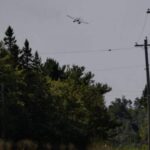The glimmering scales of wild salmon—once abundant in Canada’s pristine waterways—are becoming an increasingly rare sight both in nature and at grocery seafood counters. Recent data from fisheries across British Columbia and the Atlantic provinces indicate an alarming decline in salmon populations, a trend that experts warn could soon hit Canadian consumers directly in their wallets.
“We’re witnessing what could be described as a perfect storm for salmon populations,” explains Dr. Marian Thompson, marine biologist at the Ocean Research Institute of Canada. “Climate change is warming waters beyond optimal temperatures, while habitat destruction and overfishing continue to stress already vulnerable stocks.”
The consequences of this decline are already visible at major Canadian retailers. At supermarkets in Toronto, Vancouver, and Halifax, salmon prices have increased by 12% over the past eight months compared to the same period last year. Industry analysts at the Canadian Seafood Alliance project these increases could accelerate to 20-25% by next summer if current population trends continue.
Wild Pacific salmon populations, including sockeye, chinook, and coho varieties, have experienced particularly troubling declines. The Department of Fisheries and Oceans Canada reported that returns to the Fraser River system were approximately 30% below the already conservative pre-season forecast, continuing a troubling multi-year trend.
For consumers, this environmental crisis translates directly to higher grocery bills. “Salmon has traditionally been positioned as a premium yet accessible protein source for Canadian families,” notes Emma Richardson, consumer market analyst at Canadian Food Insights. “At current trajectory, it risks becoming a luxury item rather than a staple in many households.”
The situation has prompted increased attention to aquaculture—farm-raised salmon—as an alternative. However, environmental concerns surrounding these operations, including potential contamination of wild stocks and the ecological impact of concentrated feeding areas, have raised questions about sustainability.
Indigenous communities along coastal regions, who have relied on salmon for thousands of years as both cultural cornerstone and essential food source, face particularly severe consequences. “This isn’t just about one food item becoming more expensive,” says William Carver, elder and fishing rights advocate from the Coast Salish Nation. “It represents a threat to traditional ways of life that have existed in harmony with these fish for countless generations.”
Federal and provincial governments have announced several initiatives aimed at salmon conservation, including habitat restoration projects and stricter fishing quotas. However, many environmental organizations argue these measures fall short of addressing the systemic challenges facing salmon populations.
For budget-conscious shoppers, nutritionists suggest considering alternative protein sources like locally-sourced freshwater fish, plant-based options, or less popular but more sustainable seafood varieties. “While salmon offers excellent nutritional benefits, particularly omega-3 fatty acids, consumers can find these nutrients in other sources that may be more affordable and sustainable,” advises registered dietitian Sophia Patel.
As Canadians face these rising costs alongside broader inflation concerns, one question becomes increasingly pressing: at what point does environmental stewardship of our natural resources become not just an ecological imperative but an economic necessity for everyday consumers?
























